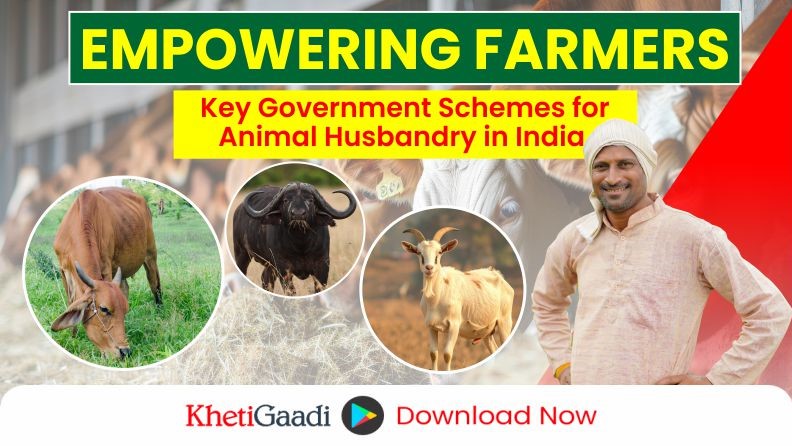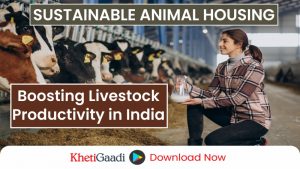Empowering Farmers for Sustainable Growth
Animal husbandry has long been the backbone of rural livelihoods in India, offering critical support to the agricultural economy. This sector not only contributes significantly to the nation’s GDP but also provides employment to millions of people in rural areas. Livestock farming, whether it is dairy, poultry, or other animal rearing, ensures a stable source of income for small and marginal farmers. Recognizing the pivotal role that animal husbandry plays, the Government of India has implemented a number of schemes designed to assist farmers in improving their productivity, adopting modern technology, and safeguarding their livestock.
In this article, we will provide an in-depth look at the key government schemes for animal husbandry, explain how these schemes benefit farmers, and showcase success stories that highlight the real-world impact of these initiatives.
Key Government Schemes for Animal Husbandry in India
1. Rashtriya Gokul Mission (RGM)
The Rashtriya Gokul Mission (RGM) is a flagship initiative under the National Programme for Bovine Breeding and Dairy Development. Launched in 2014, this scheme focuses on the preservation and development of indigenous breeds of cattle. Indian indigenous breeds such as Gir, Sahiwal, Rathi, Tharparkar, and Red Sindhi are known for their superior genetic traits, and the mission seeks to enhance their milk productivity while ensuring their conservation.
Key Features:
- Establishment of Gokul Grams as integrated indigenous cattle development centers.
- Gokul Grams are established in rural areas, promoting traditional cattle rearing methods alongside scientific advancements.
- Assistance is provided for breed improvement through Artificial Insemination (AI) and genetic mapping.
- Financial aid is available for the establishment of IVF labs for cattle.
Benefits for Farmers:
- Farmers are given access to high-quality indigenous breeds that yield higher milk production.
- The focus on artificial insemination and scientific breeding helps in improving herd productivity.
- Farmers can avail subsidies for building cattle shelters and improving feed management, reducing input costs.
For more details: Rashtriya Gokul Mission
2. National Livestock Mission (NLM)
Launched in 2014-15, the National Livestock Mission (NLM) aims at the sustainable development of the livestock sector by focusing on improving livestock productivity, enhancing feed and fodder availability, and promoting entrepreneurship.
Key Features:
- Provides financial assistance for poultry farming, goat rearing, and sheep farming.
- Supports the development of backyard poultry, which offers a low-cost way for farmers to start small-scale ventures.
- Financial aid is available for the establishment of feed processing units, ensuring quality nutrition for animals.
- Emphasis on breed improvement through genetic enhancement and better access to breeding stock.
- Risk management mechanisms such as insurance for livestock and farmer capacity-building programs.
Benefits for Farmers:
- Farmers can access subsidies for setting up livestock units such as goat farms and poultry sheds, which provides new income streams.
- Improved access to fodder and feed at reduced costs directly increases livestock health and productivity.
- By ensuring livestock insurance, farmers are protected from losses in case of animal deaths or disease outbreaks.
Learn more: National Livestock Mission
3. Dairy Entrepreneurship Development Scheme (DEDS)
The Dairy Entrepreneurship Development Scheme (DEDS) aims to enhance the dairy sector by providing financial assistance to farmers, especially small and marginal dairy farmers. This scheme promotes modern dairy farms and encourages the production of quality milk and other value-added dairy products.
Key Features:
- Farmers can avail of subsidies of up to 25% for general category farmers and 33.33% for SC/ST farmers to set up small dairy farms.
- Assistance is available for the purchase of milk-processing equipment, allowing farmers to produce cheese, yogurt, butter, and other dairy products.
- Focus on improving milk production through advanced feeding practices and animal health management.
- Financial support for establishing cold chain infrastructure like refrigeration units for storing milk.
Benefits for Farmers:
- The subsidy reduces the initial investment cost, making it easier for small farmers to enter the dairy business.
- Modern equipment and better management practices lead to higher productivity and better milk quality.
- The ability to produce and market value-added products such as butter and cheese increases income diversification.
For more details: Dairy Entrepreneurship Development Scheme
4. National Animal Disease Control Programme (NADCP)
Diseases such as Foot and Mouth Disease (FMD) and Brucellosis are major threats to livestock productivity in India. The National Animal Disease Control Programme (NADCP) is an ambitious government initiative aimed at eradicating these diseases by conducting large-scale vaccination campaigns.
Key Features:
- 100% funding is provided by the central government to vaccinate livestock against FMD and brucellosis.
- The programme targets the vaccination of over 500 million livestock, including cattle, buffaloes, and goats.
- The scheme also includes the establishment of disease-free zones and the creation of a robust surveillance system for livestock health.
Benefits for Farmers:
- Disease-free livestock ensures better milk and meat production, translating into higher earnings for farmers.
- Timely vaccinations reduce the risk of disease outbreaks, which can decimate livestock populations.
- Better animal health management leads to increased productivity and lower veterinary costs.
Learn more: National Animal Disease Control Programme
5. Pashu Kisan Credit Card (PKCC)
The Pashu Kisan Credit Card Scheme is aimed at providing farmers with access to short-term credit for the care and maintenance of their livestock. The scheme functions similarly to the Kisan Credit Card, but is specifically tailored for livestock farmers.
Key Features:
- Loans of up to ₹1.6 lakhs for dairy cattle and buffaloes, and ₹72,000 for sheep, goats, and pigs at low-interest rates.
- Easy and flexible repayment options, with interest subsidies for timely repayment.
- Funds can be used for feed, fodder, medicines, and other operational needs.
Benefits for Farmers:
- Low-interest loans help reduce financial stress and ensure farmers can maintain livestock health efficiently.
- The flexible repayment structure ensures farmers don’t face financial burden, even during low-profit months.
- With easy access to funds, farmers can focus on increasing productivity and expanding operations.
For more details: Pashu Kisan Credit Card
6. Livestock Insurance Scheme
Launched under the National Livestock Mission, the Livestock Insurance Scheme offers coverage for farmers against the loss of their livestock. The scheme provides financial compensation in the event of the untimely death of livestock due to accidents, diseases, or natural disasters.
Key Features:
- Coverage for up to 50% of the premium cost for two animals per farmer.
- Insurance is available for major livestock like cows, buffaloes, and sheep.
- A speedy claim process ensures that farmers receive financial compensation in a timely manner.
Benefits for Farmers:
- Livestock insurance provides a financial safety net for farmers, protecting them from severe losses.
- The subsidy on premium costs makes the scheme affordable for small and marginal farmers.
- Compensation helps farmers reinvest in new livestock, ensuring a continuous source of income.
For more details: Livestock Insurance Scheme
Success Stories
1. Empowering Dairy Farmers in Maharashtra
- Background: A group of farmers in rural Maharashtra adopted the Dairy Entrepreneurship Development Scheme to set up small dairy units. With modern dairy equipment and government support, they saw a significant increase in milk production.
- Result: Milk production surged by 40%, and farmers like Mr. Nandeshwar from Nashik reported an increase in income from ₹60,000 to ₹1,20,000 annually.
- Impact: The scheme helped in improving livelihoods, allowing farmers to expand their operations and sell value-added products such as yogurt and butter.
2. Reviving Indigenous Cattle in Rajasthan
- Background: Under the Rashtriya Gokul Mission, efforts were made to revive the Tharparkar breed, indigenous to Rajasthan. The government provided financial assistance for establishing Gokul Grams and modern cattle-rearing techniques.
- Result: Farmers like Ms. Geeta Devi from Barmer district saw a 30% increase in milk yields and an additional income of ₹10,000 per month.
- Impact: Indigenous breeds, once on the verge of decline, are now contributing significantly to the local dairy industry, ensuring sustainable farming practices.
3. Sustainable Goat Farming in Uttar Pradesh
- Background: With the help of subsidies from the National Livestock Mission, Mr. Anwar from a village in Uttar Pradesh started a goat farm. Government support for breed improvement and infrastructure helped him establish a sustainable farm.
- Result: Starting with just 20 goats, his farm has grown to over 150, generating annual profits of ₹2 lakhs.
- Impact: The scheme not only provided financial stability but also created employment opportunities for other villagers.
Conclusion
India’s animal husbandry sector is set to grow exponentially with the support of these government schemes. By improving livestock productivity, offering financial support, and ensuring better health management practices, these initiatives are transforming the lives of farmers across the country. With continued investment in technology, infrastructure, and capacity building, animal husbandry will remain a pillar of rural economic growth, providing a pathway for sustainable livelihoods and poverty alleviation.
Farmers can access these schemes through local agricultural offices, banks, and online portals to receive the benefits and contribute to India’s livestock-driven economy.


